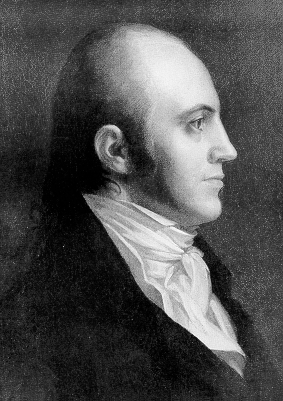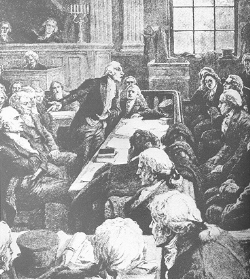
Never has an American trial produced such an impressive set of key players:
the defendant-- Aaron Burr, founding father, Vice President, and slayer of Alexander Hamilton in their famous duel three years earlier;
the trial judge--John Marshall, Chief Justice of the United States Supreme Court (and the most important justice in history);
the force behind the prosecution--Thomas Jefferson, author of the Declaration of Independence and president of the United States;
defense attorneys--Edmund Randolph and Luther Martin, both delegates to the Constitutional Convention and among the most prominent men of the day; prosecutors--Charles Lee, former Attorney General, and William Wirt, future presidential candidate.
The high-stakes treason trial of Aaron Burr came at an unstable time, both in Europe and in America. The American and French revolutions worried traditional European powers, Great Britain and Spain, who were determined to keep the radical new doctrine from undermining the power of their royalty. Meanwhile, Napoleon's empire-building produced sustained military conflict on the Continent.
The United States seemed on the verge of a war with Spain, even as the Administration struggled to preserve neutrality. Americans west of the Alleghenies rejoiced in President Jefferson's acquisition of the Louisiana Territory, but boundary disputes and Spanish prohibitions on Louisiana residents' entry into Nueva Espana created resentment and threats of reprisal. The Viceroy of Mexico, allied generally with western Indians, sent troops to the Sabine River to protect the Spanish frontier from invasion by United States citizens. Most Westerners saw Spain as tyrannical and viewed Texas and Florida as a rightful part of the United States. Many of these same Westerners expressed a willingness to take Spanish territory by force. Meanwhile, Spain also worried about the designs of residents of its own dominion (especially Mexico), recognizing that the unprivileged masses had grown resentful of Spanish authority.
The Burr Conspiracy
Aaron Burr
In this troubled time, the end of President Jefferson's first term, Aaron Burr stepped down from the Vice Presidency, and began preparations for a military expedition that was either--depending upon whose views one solicited--treasonous or patriotic. At its core, however, the Burr Conspiracy clearly was about conquest and adventure.
The Burr Conspiracy had its origins in a series of discussions over the winter of 1804-05 between Burr and his longstanding friend, General James Wilkinson. The two served together in the Quebec campaign of 1775-76. Over the years they often corresponded in a cipher invented by Wilkinson. Wilkinson was an intriguer of the first-order who had formerly been the head of a party in the West that favored a separation of the western states from the Atlantic states.
Burr left Washington for a tour of the West in March of 1805. His first stop was in Philadelphia, where he met with Anthony Merry, the British Minister to the United States. Merry reported details of his conversation in a letter to London:
"I am encouraged to report to your Lordship the substance of some secret communications which [Burr] has sought to make to me since he has been out of office...Mr. Burr has mentioned to me that the inhabitants of Louisiana [the lands recently purchased from France] seem determined to render themselves independent of the United States and the execution of their design is only delayed by the difficulty of obtaining previously an assurance of protection and assistance from some foreign power....It is clear that Mr. Burr means to endeavor to be the instrument for effecting such a connection....He pointed out the great commercial advantage which his Majesty's dominions in general would derive from furnishing almost exclusively (as they might through Canada and New Orleans) the inhabitants of so extensive a territory....Mr. Burr observed it would be too dangerous and even premature to disclose to me at present the full extent and detail of the plan he had formed....In regard to military aid, he said, two or three frigates and the same number of smaller vessels to be stationed at the mouth of the Mississippi to prevent its being blockaded by such force as the United States could send, and to keep open the communications with the sea would be the whole that would be wanted; and in respect to money the loan of about one hundred thousand pounds would, he conceived, be sufficient for the immediate purposes of the enterprise."
On April 29, 1805, Burr reached Pittsburgh, where he planned to meet with General Wilkinson, the new Governor of the just-organized Louisiana Territory. But Wilkinson had been delayed, so Burr left a letter for him and set off down the Ohio River in a specially prepared boat (called by Burr his "ark").
In early May, Burr reached Blennerhassett's Island , a three-hundred-acre piece of land in the river. The island belonged to an Irish gentleman named Harman Blennerhassett. Blennerhassett invited Burr to dinner. The conversation that ensued--lasting until eleven o'clock in the evening--would forever link Blennerhassett's Island with the Burr Conspiracy. The precise nature of the plans discussed over dinner is not known, but some inkling may be gleaned from a letter sent by Blennerhassett later that year to Burr:
"I should be honored in being associated with you, in any contemplated enterprise you would permit me to participate in....Viewing the probability of a rupture with Spain,...I am disposed, in the confidential spirit of this letter, to offer you and my friends' and my own services in any contemplated measures in which you may embark."
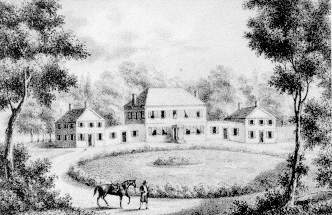
Mansion owned by Harmon Blennerhassett
Continuing down the river, Burr met with others who would later be connected with his conspiracy. In Cincinnati, Burr visited with his friend, former Ohio Senator Jonathan Dayton, later indicted with Burr for treason. Burr left his "ark" in Louisville to travel overland to Nashville, where he received a very enthusiastic welcome of dinners and balls from the local population. In Nashville, Burr stayed as the guest of General Andrew Jackson. After resuming his river voyage, Burr finally met General Wilkinson at Fort Massac. (Wilkinson would later describe his conversations with Burr as perfectly legitimate, but there is strong suspicion that this opportunity was used to detail plans for Burr's western aggression.) Wilkinson provided Burr with "an elegant barge, sails, colors, ten oars, with a sergeant and ten able, faithful hands," as well as a letter of introduction to friends in New Orleans, Burr's ultimate destination.
Burr loved New Orleans enough to want to settle there, he said, "were it not for [his daughter] Theodosia and her boy." He used his time in New Orleans to gauge public opinion concerning Mexico and to discuss possible enterprises with persons sympathetic to a Mexican insurrection. Burr's principal contact in New Orleans, wealthy merchant and political leader Daniel Clark, promised $50,000 in support of Burr's projects and subsequently traveled to Mexico to gather information on the strength of Spanish fortresses and the attitudes of the people to Spanish control. Clark told at least one witness that he "might be a duke" in the new empire that would rise after the Burr expedition's conquest .
Burr left New Orleans in late July of 1805, beginning a four-month tour that included another meeting with General Wilkinson in St. Louis. It was at this time, according to Wilkinson's later and probably self-serving report, that he said he began to suspect Burr of treasonous intentions. He quoted Burr as denouncing "the imbecility of the Government" and that "the people of the western country were ready for revolt." Wilkinson claimed to have responded to Burr's interpretation of western sentiments, "Surely, no person was ever more mistaken! The western people disaffected to the Government? They are bigoted to Jefferson and democracy?"
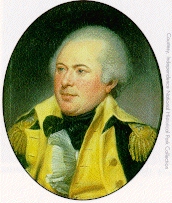
General James Wilkinson
Burr's long western sojourn finally ended with his arrival back in Washington in October. Over the winter of 1806-06, Burr met frequently with disaffected military leaders such as Commodore Truxton and General Eaton, urging that he join in his western adventure. He sent letters to supporters he had identified on his western trip and enlisted the full support of his beloved daughter Theodosia.
In mid-summer, Burr (and Theodosia and her young child) set off again for western lands. Burr continued to sound out potential backers for his military expedition. In western Pennsylvania, hoping to enlist the support of influential Colonel Morgan and his two sons, Burr made the fatal mistake of expressing plans which his host found shocking. Morgan wrote a letter to President Jefferson summarizing his conversation with Burr, setting in motion the Administration effort that would eventually put an end to Burr's dreams and lead to his arrest and trial. Morgan would later provide testimony of his conversation with Burr at his 1807 trial:
After dinner I spoke of our fine country. I observed that when I first went there, there was not a single family between the Allegheny mountains and the Ohio; and that by and by we should have congress sitting in this neighborhood or at Pittsburg. We were allowed to sport these things over a glass of wine: "No, never," said Colonel Burr, "for in less than five years you will be totally divided from the Atlantic states." The colonel entered into some arguments to prove why it would and must be so....He said that our taxes were very heavy, and demanded why we should pay them to the Atlantic parts of the country?....I began to think that all was not right. He said that with two hundred men he could drive congress, with the president at its head, into the river Potomac, or that it might be done; and he said with five hundred men he could take possession of New York....
By the end of August, Burr was back on Blennerhasset's Island making final preparations for his expedition. He contracted to purchase fifteen boats capable of carrying 500 men, and a large keel boat for transporting provisions. He made orders for huge quantities of pork, corn meal, flour, and whiskey. Later, in Nashville, he contracted for six more boats, giving $4,000 to Andrew Jackson to pay for them.

Blennerhasset Island in the Ohio River
Burr also bought a 300,000-acre tract of land on the Washita River, an area known as the Bastrop land. In his efforts to recruit volunteers for the expedition, Burr promised them a share of the Washita tract.
The Conspiracy Defeated
By this time, if not earlier, General Wilkinson had decided to abandon the Conspiracy. When, in early October, a ciphered letter sent by Burr and borne by his trusted aide Samuel Swarthout reached Wilkinson in New Orleans, Wilkinson determined to squash Burr's plans. He rushed troops to the Mississippi Valley and ordered troops in New Orleans to be on alert for an attack. Burr's ciphered letter (decoded by Wilkinson), together with one from co-conspirator Senator Dayton, he sent to President Jefferson. The letter, which some consider to be the most important evidence of a Burr Conspiracy, read:
I have obtained funds, and have actually commenced the enterprise. Detachments from different points under different pretenses will rendezvous on the Ohio, 1st November-- everything internal and external favors views--protection of England is secured. T[ruxton] is gone to Jamaica to arrange with the admiral on that station, and will meet at the Mississippi-- England---Navy of the United States are ready to join, and final orders are given to my friends and followers--it will be a host of choice spirits. Wilkinson shall be second to Burr only--Wilkinson shall dictate the rank and promotion of his officers. Burr will proceed westward 1st August, never to return: with him go his daughter--the husband will follow in October with a corps of worthies. Send forthwith an intelligent and confidential friend with whom Burr may confer. He shall return immediately with further interesting details--this is essential to concert and harmony of the movement.... [T]he project is brought to the point so long desired: Burr guarantees the result with his life and honor--the lives, the honor and fortunes of hundreds, the best blood of our country. Burr's plan of operations is to move rapidly from the falls on the 15th of November, with the first five hundred or one thousand men, in light boats now constructing for that purpose--to be at Natchez between the 5th and 15th of December--then to meet Wilkinson--then to determine whether it will be expedient in the first instance to seize on or pass by Baton Rouge. On receipt of this send Burr an answer--draw on Burr for all expenses, &c. The people of the country to which we are going are prepared to receive us--their agents now with Burr say that if we will protect their religion, and will not subject them to a foreign power, that in three weeks all will be settled.
The gods invite to glory and fortune--it remains to be seen whether we deserve the boon.... --29th July.
President Jefferson responded to Wilkinson's letter by signing a proclamation stating that "sundry persons...are conspiring...to...set on foot...a military expedition against the dominions of Spain." He urged all military and other government officials to devot their attentions to "searching out and bringing to condign punishment all persons engaged or concerned in such enterprise."

President Thomas Jefferson
The president sent west a confidential agent, a State Department clerk named Graham, to investigate the Burr plot. Graham, deceiving Harman Blennerhassett into believing he was a fellow conspirator, uncovered important details concerning Burr's plans. Graham then proceeded to the Ohio capitol of Chillicothe, where he convinced the Governor to order out the militia to seize the boats Burr had ordered for his expedition. On December 9, 1806, just two days after the first four of the fifteen boats Burr purchased arrived, with two key Burr confederates and thirty men at Blennerhassett Island, the militia seized the remaining eleven boats, still in storage at Marietta, Ohio. The boats had been scheduled to be delivered to Blennerhassett the next day.
Word of the boat seizure reached the Burr confederates within hours after it took place. Plans were made for a hasty departure from the island. About midnight of December 9, four boats pushed off and began heading down the Ohio. The next morning the militia reached Blennerhassett Island only to find it empty. Perhaps out of frustration, they destroyed the fine furniture, vases, and art of Blennerhassett's mansion, fired rifle balls through his painted ceilings, and drank the whiskey stored in his cellar.
Burr was in Nashville when he learned that federal authorities were out to crush his plans. On November 22, he beat a hurried retreat down the Cumberland River. All the Burr detachments met up at the Falls of the Ohio. Addressing his recruits, Burr told them that he had intended at this point to describe their specific objective, but circumstances had caused him to defer doing so. Instead, the flotilla would head down the Mississippi, where Burr--still ignorant of Wilkinson's betrayal--expected military backing. Only upon reaching Bayou Pierre, thirty miles above Natchez, did Burr learn that Wilkinson had turned from co-conspirator into his pursuer. Burr wrote a public letter declaring the innocence of his intentions: "If the alarm which has been excited should not be appeased by this declaration, I invite my fellow citizens to visit me at this place, and to receive from me, in person, such further explanations as may be necessary to their satisfaction, presuming that when my views are understood, they will receive the countenance of all good men."
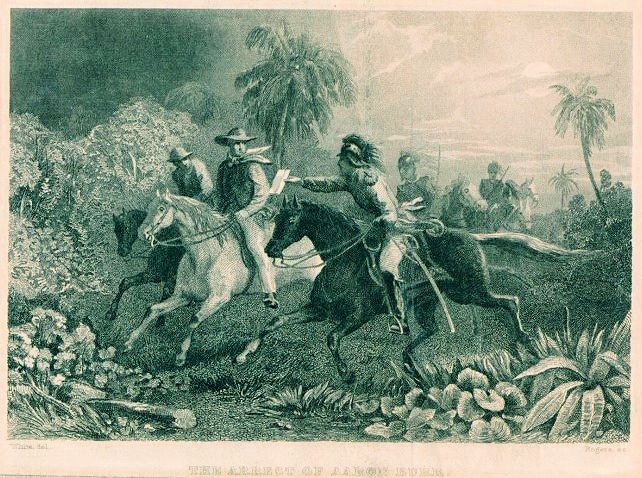
The arrest of Aaron Burr
A militia detachment of thirty men caught up with Burr when he and his expedition of between sixty and one hundred men were camped across from Natchez, on the west bank of the Mississippi. Burr was handed a letter from the Governor of Mississippi demanding his surrender. Burr responded to the letter by denouncing Wilkinson whose "perfidious conduct" had "completely frustrated" his "projects."
The next day Burr met with the Governor who convinced him to surrender and allow himself to be conducted to the nearby town of Washington. A grand jury, after listening to evidence against Burr, declared Burr "not guilty of any crime or misdemeanor against the United States." The jury went on to condemn the arrest, suggesting that it had given cause to "the enemies of our glorious Constitution to rejoice." Burr demanded and received his release. He disguised himself as a boatman and disappeared into the wilderness on the eastern side of the Mississippi.
Once additional information about Burr's activities became known, a new warrant was issued for his arrest. Arrest finally came in mid-February on the Tombigbee River, in present day Alabama. Burr was taken to Fort Stoddart for two weeks, then conducted by a nine-man military guard on a one-thousand-mile horseback trip to Richmond, where he would stand trial for treason.
The Trial
On March 26, 1807, Burr arrived in Richmond, Virginia and lodged, under guard, in the Eagle Hotel. Four days later he was brought to another room in the hotel for an examination before the judge who would conduct his trial. The judge was none other than the Chief Justice of the United States, John Marshall.
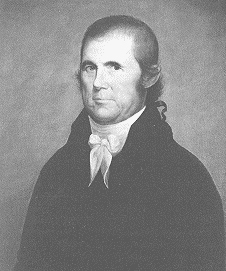
Chief Justice John Marshall
The examination began with District Attorney George Hay (the son-in-law of future President James Monroe) supporting the government's motion for commitment on charges of treason and "high misdemeanors." Hay argued that the evidence showed that Burr intended to take New Orleans by force and make it the capitol of his new western empire. Replying for Burr, Defense Attorney Edmund Randolph (former Attorney General and Secretary of State under President Washington) argued that Burr committed no overt act of treason. Burr also addressed the Court. He offered an innocent interpretation of his own actions and emphasized his acquittal by a grand jury in the Mississippi Territory. He complained bitterly about his recent treatment, telling Marshall he had been denied the use of ink and paper--not even permitted to write to his daughter.
On April 1, Chief Justice Marshall delivered his opinion on the government's motion. Marshall concluded that the prosecution failed to produce sufficient evidence of treason. He scheduled Burr for trial on the high misdemeanor charge and set bail at $10,000. Marshall's refusal to insert the treason charge enraged President Jefferson, who suspected that the Chief Justice's judgment was warped in favor of Burr by his own dislike of Jefferson and the course of his Administration.
Jefferson took it as a personal mission to secure Burr's conviction. He had printed circulars sent out throughout the western country asking "every good citizen to step forward, and communicate to the government any information he may possess." He dispatched a deputy marshal to take depositions near Blennerhassett Island. Secretary of State James Madison wrote Andrew Jackson, requesting that he help gather depositions from around Tennessee that might help convict Burr. Meanwhile in New Orleans, Wilkinson sent out numerous agents to collect whatever evidence they could.
Jefferson's own view of Burr's actions is best revealed in his letters of 1807. He saw that Burr's "first enterprise was to have been the seizure of New Orleans" which would "place him at the door of Mexico." His plan, according to Jefferson, included "separating the western states from us, of adding Mexico to them, and of placing himself at their head." "Burr's conspiracy" was, Jefferson concluded, "one of the most flagitous of which history will ever furnish an example." According to Jefferson, Burr abandoned his original plan to separate the western states from the Union only because "he very early saw that the fidelity of the western country was not to be shaken." As a result, "he turned himself wholly to Mexico."
Shortly after noon on May 22, 1807, the trial of Aaron Burr opened in Richmond. On the bench sat Chief Justice Marshall and Virginia District Judge Cyrus Griffin. Surrounding Burr was his team of defense lawyers including Edmund Randolph, John Wickham, Benjamin Botts, Charles Lee, and Luther Martin, a former Maryland delegate to the Constitutional Convention often called the "Thersites of the law." (In addition, Burr himself would play a major role in the trial, cross-examining most of the prosecution's witnesses himself.) The cast for the prosecution included George Hay, Caesar Rodney, William Wirt, and Alexander McCrae.

Defense attorney Luther Martin
While a grand jury awaited the arrival of General Wilkinson from New Orleans, Chief Justice Marshall considered both prosecution and defense motions.
The prosecution, noting that "the evidence is different now," again moved for commitment of Burr on the charge of treason. The defense countered, arguing that to establish the crime of treason the prosecution must prove that an overt act of treason had been committed by the defendant in a war and that, under the Constitution, the overt act must be testified to by two witnesses and must have occurred in the district of the trial. When Marshall sided with the defense's narrow interpretation of treason, the prosecution knew it had its back to the wall.
Marshall also weighed a defense motion for a subpoena duces tecum to be directed to the President, requiring that he turn over certain letters from Wilkinson that might be helpful to the defense. Luther Martin, arguing for his motion, declared:
"The President has undertaken to prejudge my client by declaring 'of his guilt there can be no doubt.' He has assumed the knowledge of the Supreme Being himself, and pretended to search the heart of my highly respected friend. He has proclaimed him a traitor....He has let slip the dogs of war, the hell-hounds of prosecution, to hunt down my friend. And would this President of the United States, who has raised all this absurd clamor, pretend to keep back the papers which are wanted for this trial, where life itself is at stake? It is a sacred principle, that in all such cases, the accused has the right to all the evidence which is necessary for his case."
On June 13, Marshall ruled that a subpoena to the President might issue. While Marshall recognized that urgent circumstances might prevent the President from complying with the subpoena, the court, he said, had "no choice" but to issue it.
Jefferson never turned over the requested letters. Marshall, having no real alternative, quietly let the matter drop. Jefferson stated his position on the matter in a letter to George Hay:
"The leading feature of our Constitution is the independence of the Legislative, Executive, and Judiciary of each other; and none are more jealous of this than the Judiciary. But would the Executive be independent of the Judiciary if he were subject to the commands of the latter, and to imprisonment for disobedience; if the smaller courts could bandy him from pillar to post, keep him constantly trudging from north to south and east to west, and withdraw him entirely from his executive duties?"
On June 15, General Wilkinson--described by the defense as "the alpha and omega of the present prosecution"--arrived in Richmond to appear before the grand jury. Author Washington Irving, a trial spectator, watched as Wilkinson "strutted into court" and "stood for a moment swelling like a turkey-cock." According to Irving, Burr "turned his head, looked him full in the face with one of his piercing regards, swept his eye over the whole person from head to foot, as if to scan his dimensions, and then coolly resume his former position."
Wilkinson's testimony had its intended effect. On June 24, the grand jury reported indictments against Burr for treason and high misdemeanor. Two days later, Burr pleaded not guilty to the charges, and the court adjourned until August 3.
A few days before testimony against him was to begin, Burr wrote to his daughter Theodosia, urging her not to attend the trial:
"I may be immured in dungeons, chained, murdered in legal form, but I cannot be humiliated or disgraced. If absent you will suffer great solicitude. In my presence you will feel none, whatever may be the malice or the power of my enemies, and in both they abound."
The Hall of the Virginia House of Delegates , the site of the trial, was filled to capacity for opening of the prosecution case in the Burr trial. Prosecutor George Hay told the jury of twelve men that the evidence would show that Burr had a "treasonable design" and that he assembled men for the purpose of furthering his treasonous aim.

Virginia House of Delegates in Richmond, scene of the Burr Trial
The prosecution called its first witness, General William Eaton. Eaton testified to a conversation that he had in Washington with Burr during the winter of 1805-6:
I listened to Colonel Burr's mode of indemnity; and as I had by this time begun to suspect that the military expedition he had on foot was unlawful, I permitted him to believe myself resigned to his influence that I might understand the extent and motive of his arrangements. Colonel Burr now laid open his project of revolutionizing the territory west of the Allegheny, establishing an independent empire there; New Orleans to be the capital, and he himself to be the chief; organizing a military force on the waters of the Mississippi, and carrying conquest to Mexico.
Other prosecution witnesses testified as to Burr's ambitious plans. Commodore Truxton said Burr "intended to attack Vera Cruz and Mexico, give liberty to an enslaved world, and establish an independent Government in Mexico." Harman Blennerhassett's gardener, Peter Taylor, described for the jury a conversation he had with Blennerhassett:
[H]e made a sudden pause, and said, "I will tell you what, Peter, we are going to take Mexico, one of the finest and richest places in the whole world." He said that Colonel Burr would be the king of Mexico, and Mrs. Alston, daughter of Colonel Burr, was to be the queen of Mexico whenever Colonel Burr died. He said that Colonel Burr had made fortunes for many in his time, but none for himself; but now he was going to make something for himself.
Taylor also described Blennerhasset's answer to his question of how he might control his recruits:
I then asked him what was to become of the men who were going to settle the lands he talk about. Were they to stop at the Red River, or to go on? He said, "Oh, by God, I tell you, Peter, every man that will not conform to order and discipline I will stab; you'll see how I'll fix them;" that when he got them far enough down the river, if they did not conform to order and discipline, he swore by God he'd stab them. I was astonished. I told him I was no soldier, and could not fight. He said it made no odds; he did not want me to fight; he wanted me to go and live with Mrs. Blennerhassett and the children, either at Natchez or some other place, while he went on the expedition. I talked to him again, and told him the people had got it into their heads that he wanted to divide the Union. He said Colonel Burr and he could not do it themselves; all they could do was to tell the people the consequence of it.
Taylor, as well as several other witnesses, were called to testify concerning events in December of 1806 at Blennerhassett's Island--the prosecution's one overt act of treason on which it pinned its case. District Attorney Hay questioned William Love about what he saw on the night of December 10:
Mr. Hay-- How many boats were at the island?
Love-- Four.
Mr. Hay--How many men?
Love-- I cannot tell you, but I suppose about betwixt twenty and twenty-five belonging to Colonel Tyler's boats. When I arrived on the island, Blennerhassett met me.
Mr. Hay-- Did you see any arms?
Love-- I saw the men and rifles. I know that Mr. Blennerhassett took away with him one brace of horse pistols, a brace of pocket pistols, and a dirk. Some fuses were put in the boat, but not more than three or four, all belonging to him.
Mr. Hay-- And what arms had Tyler's men?
Love-- Pistols, dirks and rifles, they brought there, but all were not armed with rifles. I know not whether they were armed with different things.
On August 20, Burr interrupted the prosecution's case to ask the court to arrest further prosecution testimony on the ground that the evidence "utterly failed to prove any overt act of war had been committed" and that he was shown to have been one hundred miles distant from Blennerhassett's Island at the time the overt act charged was shown to have taken place. Several days of argument on Burr's motion followed. Chief Justice Marshall offered his praise for the lawyers who participated, saying that they presented their arguments with "a degree of eloquence seldom displayed on any occasion." It took Marshall three hours to read his lengthy opinion. When he had finished, he had swept away the prosecution's case. Marshall ruled that Burr could not be found to have committed treason based on the events at Blennerhassett's Island: "If those who perpetrated the fact be not traitors, he who advised them [Burr] cannot be a traitor." Marshall stated that we would exclude testimony "relative to the conduct or declarations of the prisoner elsewhere and subsequent to the transaction on Blennerhassett's Island." Moreover, to be guilty, the prosecution had to prove that there had been an "actual use of force" and that Burr was "connected to that use of force." Marshall demanded that the government prove what it could not prove.
Marshall's decision ended the prosecution's case and on September 1, the case was sent to the jury. They had little choice. Nonetheless, the jury hinted that they might have decided the case differently, but for the court's instructions: "We of the jury say that Aaron Burr is not proved to be guilty under this indictment by any evidence submitted to us. We therefore find him not guilty."
A few weeks later, the jury also acquitted Burr on the Neutrality Act charge. Aaron Burr was a free man. Or almost free. John Marhsall conceded that the prosecution had a point. Down rivers farther west than Virginia, Burr had travelled with his men, their weapons, and their ammunition. "The very sould of the expedition," as a prosecutor had put it. Even if Burr could not be convicted for what he did in Virginia, perhaps he could be tried and possibly convicted in a western court. Marshall ordered Burr to appear in Chillicothe, Ohio to defend himself one more time--on another charge of violating the Neutrality Act. But that would never happen. Burr posted bail, then headed north, not west--he had no intention of ever seeing the inside of a courtroom again.
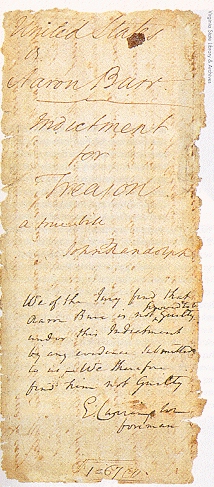
Verdict sheet from the Burr trial
Trial Aftermath
President Jefferson fumed over Marshall's ruling. He said "It now appears we have no law but the will of the judge." He contemplated responses ranging from proposing a constitutional amendment limiting the power of the judiciary to asking Congress to impeach the Chief Justice. In a letter to General Wilkinson, Jefferson wrote:
The scenes which have been acted at Richmond are such as have never been exhibited in any country, where all regard to public character has not yet been thrown off. They are equivalent to a proclamation of impunity to every traitorous combination which may be formed to destroy the Union."
Burr, despite his acquittal, stood disgraced. Although he would live another twenty-nine years, he would never again be a significant player in American public life. In 1808, he sailed for Europe, where he would remain for four years. The death of his beloved daughter Theodosia, lost at sea while sailing to meet her father in New York upon his return, seemed to end whatever spark remained within him. Years later, when he heard news of the Texas Revolution, Burr exclaimed to a friend with satisfaction: "There! You see? I was right! I was only thirty years too soon. What was treason in me thirty years ago, is patriotism now."
Even today, it is hard to say whether Aaron Burr was guilty of treason. As Burr biographer Buckner Melton notes, "Too many people told too many different stories, and too many people had things to hide." But Burr's trial did answer more important questions--and raised yet others. John Marshall used the trial to establish the precedent that, in the United States, no man--even the president--is above the law. Moreover, Marshall put his great weight on the side of narrow interpretations of criminal statutes. Even the Devil deserves the benefit of law or freedom for all of us is at risk. The trial also raised the question of whether politics and justice can be kept entirely separate. Jefferson's meddling, in the end, probably hurt Burr's prosecution more than it helped it. Don't mess with a smart and wily judge.

